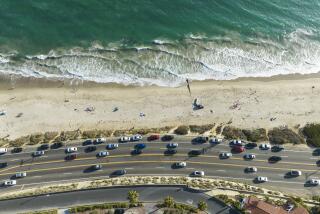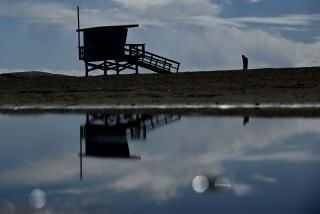Study Finds No Single Source of ’99 Huntington Coast Pollution
There is a growing consensus among Orange County sanitation officials and scientists that the 1999 beach closures in Huntington Beach may have been caused not by a single source of pollution but by several factors occurring at one time.
The district this week released an exhaustive, $5-million study that did not find a definitive source for the high bacteria levels at the beach. The study found no substantial evidence that sewage dumped from an outfall four miles offshore was the cause, but scientists could not rule it out either.
The findings match what other outside scientists are beginning to believe: that a multitude of problems--from dirty urban runoff to leaking sewer pipes--caused pollution levels to spike that summer.
If this “multiple-source” theory proves true, it’s a mixed blessing for Huntington Beach residents and merchants who worry bacteria levels could again rise, closing the coastline once again.
On the one hand, some of the pollution sources cited by scientists have since been fixed. But because there are so many possible causes for the high bacteria counts, it makes it more difficult to develop a single “magic bullet” that could fix the problem.
“Cumulatively, these things do not constitute a big smoking gun,” said Kelly Christensen, a sanitation district environmental engineer.
Among the possible culprits for the pollution:
* Sewage leaks at several restrooms at Huntington State Beach. The leaks have been repaired.
* Contaminated water leaking from the Huntington Beach flood control channel at Pacific Coast Highway and Beach Boulevard into a salt marsh. The leak has been repaired.
* Leaks in a 21-inch Orange County Sanitation District sewer line, which will soon be replaced.
* Two trailer parks--one in Huntington Beach and the other in Newport Beach--use old sewer lines that leak badly. Each city is repairing the lines.
* Dirty runoff from storm drains near the Huntington Beach Pier and around the mouth of the Santa Ana River.
* Waste from several hundred gulls that spend nighttime hours resting just beyond the surf zone.
Environmentalists and some scientists remain convinced that the sanitation district’s sewage outfall is also a cause of the pollution.
“To argue about whether we should be dumping 240 million gallons of partially treated sewage in the ocean is like arguing how deck furniture on the Titanic is arranged,” said Christopher Evans, executive director of the Surfrider Foundation, a San Clemente-based environmental group. “It’s goofy in the extreme.”
Until recently, officials have said a sewage plume emanating from the outfall does not come closer than half a mile from the shoreline--and usually is farther out.
But Cynthia Cudaback, a UC Santa Barbara scientist who served as a peer reviewer analyzing the sanitation district report findings, said that there may be some transport from the plume onto the shore--but at levels lower than state standards.
The study was launched after Stanley Grant, a UC Irvine scientist, theorized that outfall may have caused the beach closures.
Grant said the results neither prove nor disprove his theory. But he believes the outfall still might be one factor.
“The surf zone is a recipient of ... contamination from a number of different sources,” he said.
Others asserted that the study did not adequately test a key part of Grant’s theory: That the AES power plants in Huntington Beach may draw the sewage plume closer to shore. The plant was not always operating while the tests were being conducted.
The study was handled by researchers from USC, the Scripps Institution of Oceanography and the U.S. Naval Postgraduate School under guidance by the U.S. Geological Survey and sanitation district scientists.
The county’s Sanitation District will soon decide whether to seek a renewal of its waiver to the federal Clean Water Act. The waiver allows the agency to treat half of the waste water it pumps into the ocean at levels less than those adopted by most of the nation’s 16,000 sanitation districts.
Environmental groups and three coastal cities, including Huntington Beach, oppose extending the waiver. Sanitation district officials say treating all of its outflow to the highest levels--by using microorganisms to eliminate bacteria and viruses--would cost more than $400 million.
More to Read
Sign up for Essential California
The most important California stories and recommendations in your inbox every morning.
You may occasionally receive promotional content from the Los Angeles Times.










